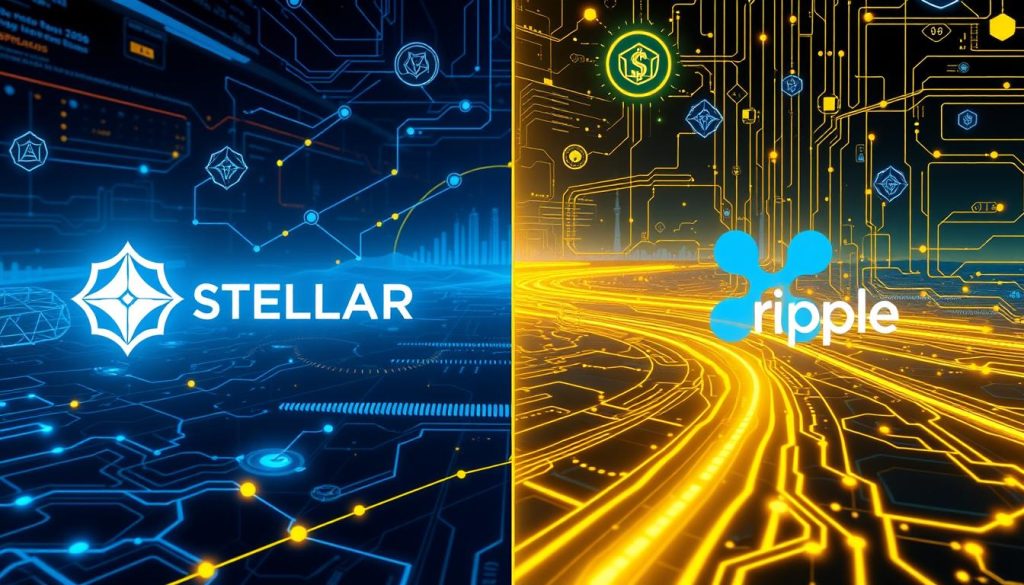Approximately 70% of cryptocurrency enthusiasts are intrigued by the differences between Stellar Lumens (XLM) and Ripple (XRP). These two blockchain platforms are at the forefront of the evolving crypto landscape. Understanding their core features, technologies, and use cases is essential for making informed decisions. This article will explore the nuances of stellar vs ripple, focusing on decentralization, partnerships, and adoption. It aims to assist readers in navigating the xlm vs xrp debate.
This guide is designed for both investors and blockchain enthusiasts. It offers a detailed comparison of stellar vs ripple, covering their technologies, use cases, and market positions. By examining the strengths and weaknesses of each platform, readers will gain a deeper understanding of the stellar vs ripple landscape. This knowledge will enable them to make informed decisions about which platform best aligns with their crypto goals.
Key Takeaways
- Stellar Lumens and Ripple are two distinct blockchain platforms with different core features and use cases.
- Understanding the differences between xlm vs xrp is crucial for making informed crypto decisions.
- Both platforms have unique approaches to decentralization, partnerships, and adoption.
- The stellar vs ripple comparison will help readers navigate the complexities of the crypto landscape.
- By examining the strengths and weaknesses of each platform, readers can make informed decisions about their crypto investments.
- The article will provide a comprehensive overview of the stellar vs ripple debate, covering technologies, use cases, and market positions.
- Readers will gain a deeper understanding of the xlm vs xrp landscape and be able to make informed decisions about their crypto goals.
Understanding the Origins and Core Philosophy
The ripple blockchain and Stellar Lumens have unique origins and philosophies. These shape their development and applications. It’s essential to grasp these differences to understand their market positions and potential.
Ripple was created to simplify cross-border transactions for financial institutions. Stellar, on the other hand, aimed at offering low-cost remittances for individuals. This distinct approach has led to different stellar lumens use cases and applications.
The Birth of Ripple and Its Vision
Ripple’s founders aimed to develop a platform for fast, secure, and affordable transactions. This vision has grown, with Ripple now offering solutions for cross-border payments.
Stellar’s Creation and Mission
Stellar was designed to facilitate low-cost remittances for individuals. Its mission is to enable fast, secure, and affordable transactions globally, focusing on developing countries.
Key Philosophical Differences
Ripple and Stellar differ in their transaction approaches and target users. Ripple aims at financial institutions, while Stellar targets individual users with low-cost remittances. This divergence has resulted in distinct ripple blockchain and stellar lumens use cases.

Understanding Ripple and Stellar’s origins and philosophies helps users appreciate their unique strengths and weaknesses. This knowledge aids in making informed decisions about which platform to use for specific needs.
| Platform | Founding Vision | Target User Base |
|---|---|---|
| Ripple | Streamline cross-border transactions for financial institutions | Banks and institutions |
| Stellar | Provide low-cost remittances for individual users | Individual users |
Technology Infrastructure and Protocol Mechanics
The ripple vs stellar technology debate extends beyond their origins. It delves into their infrastructure and protocol mechanics. These technical aspects are key to assessing scalability, security, and usability. By studying Ripple and Stellar Lumens’ technical specifications and whitepapers, we uncover their distinct approaches to decentralization and protocol mechanics.
The consensus mechanism is central to the ripple vs stellar technology comparison. Ripple’s XRP Ledger relies on a distributed consensus mechanism. In contrast, Stellar Lumens uses a federated Byzantine agreement (FBA) algorithm. These consensus mechanisms significantly impact transaction speeds, network security, and usability.

Exploring the technical sides of ripple vs stellar technology reveals both platforms’ strengths and weaknesses. Understanding these technical differences helps readers make informed choices. Whether you’re an experienced investor or new to the scene, diving into the ripple vs stellar technology world offers valuable insights. It sheds light on the future of finance and blockchain technology’s potential.
Stellar Lumens vs Ripple: Key Differences in Network Operations
Both Stellar Lumens and Ripple operate their networks differently, affecting their performance and user experience. It’s essential to understand these differences to choose the right platform for your needs. Stellar Lumens stands out for its fast and secure transactions, making it ideal for cross-border payments.
Stellar uses a federated Byzantine agreement (FBA) algorithm for faster transaction processing. In contrast, Ripple’s distributed consensus mechanism allows for quick validation of transactions. Ripple’s partnerships with financial institutions have boosted its adoption and industry recognition.
Transaction speed is another critical factor. Stellar’s network can handle up to 1,000 transactions per second. Ripple’s network, on the other hand, can process around 1,500 transactions per second. This speed difference is crucial for users with high-volume transactions.
| Platform | Consensus Mechanism | Transaction Processing Speed |
|---|---|---|
| Stellar Lumens | Federated Byzantine Agreement (FBA) | Up to 1,000 transactions per second |
| Ripple | Distributed Consensus Mechanism | Up to 1,500 transactions per second |
By comparing these operational differences, users can make informed choices. Whether it’s the stellar blockchain benefits or the ripple partnerships that matter, understanding these aspects is key.
Target Markets and Use Cases
Ripple and Stellar have distinct approaches to targeting markets and use cases, reflecting their unique philosophies and technological capabilities. Ripple focuses on serving financial institutions, aiming to streamline their cross-border transactions, notably for ripple for banks. This enables banks to cut transaction costs and boost efficiency.
On the other hand, Stellar targets individual users, focusing on low-cost stellar for remittances. This strategy allows individuals to send and receive money across borders at a lower cost and with greater speed. These strategies significantly impact adoption, partnerships, and the overall ecosystem of each platform.
Ripple’s Institutional Focus
Ripple’s focus on financial institutions has led to partnerships with major banks and financial services companies. This has enabled Ripple to develop a robust network of institutional users. It facilitates cross-border transactions and promotes the use of ripple for banks.
Stellar’s Individual User Approach
Stellar’s approach to individual users has led to the development of a range of applications and services, including low-cost stellar for remittances. This has enabled individuals to send and receive money across borders at a lower cost and with greater speed. It promotes financial inclusion and accessibility.
Cross-Border Payment Solutions
| Platform | Target Market | Use Case |
|---|---|---|
| Ripple | Financial Institutions | Cross-border transactions |
| Stellar | Individual Users | Low-cost remittances |
Understanding the target markets and use cases of Ripple and Stellar is crucial for navigating the complex landscape of cryptocurrency and blockchain technology. Recognizing the unique strengths and approaches of each platform helps users make informed decisions about which platform to use for their specific needs.
Token Economics and Distribution Models
The token economics and distribution models of Ripple and Stellar Lumens are crucial aspects of their ecosystems. When comparing xlm vs xrp, it’s essential to consider the token supply, distribution strategies, and economic policies of both platforms. This comparison will help us understand how these factors influence market dynamics, user adoption, and long-term sustainability.
A key difference between the two platforms is their approach to token distribution. Ripple has a more centralized approach, with a large portion of its tokens held by the company and its founders. In contrast, Stellar Lumens has a more decentralized approach, with a larger portion of its tokens distributed to the community through its Direct Sign-up Airdrop Program.
The following table summarizes the token economics and distribution models of Ripple and Stellar Lumens:
| Platform | Token Supply | Distribution Model |
|---|---|---|
| Ripple | 100 billion XRP | Centralized, with a large portion held by the company and its founders |
| Stellar Lumens | 50 billion XLM | Decentralized, with a larger portion distributed to the community through its Direct Sign-up Airdrop Program |
Understanding the token economics and distribution models of Ripple and Stellar Lumens is vital for making informed decisions about xlm vs xrp. By considering these factors, users can better evaluate the potential risks and rewards of each platform. This knowledge is crucial for making more informed investment decisions.
Partnership Ecosystems and Adoption Rates
The growth and acceptance of Ripple and Stellar Lumens can be measured by their partnership ecosystems and adoption rates. Ripple partnerships have been a key factor in the platform’s success, with major institutions and banks integrating the technology into their systems. In contrast, Stellar Lumens has focused on individual users and smaller organizations, creating a diverse and widespread network.
When comparing stellar vs ripple 2025, it’s essential to consider the geographic distribution of their usage. Ripple has a strong presence in North America and Europe, while Stellar Lumens has gained traction in Asia and Africa. This difference in adoption patterns can be attributed to the platforms’ distinct approaches to partnerships and user acquisition.
The adoption metrics and growth patterns of both platforms are also worth examining. The table below provides an overview of their performance in recent years:
| Platform | Partnerships | Geographic Distribution | Adoption Rate |
|---|---|---|---|
| Ripple | 100+ institutional partners | North America, Europe | 20% annual growth |
| Stellar Lumens | 50+ individual and organizational partners | Asia, Africa | 30% annual growth |
Regulatory Compliance and Legal Considerations
Understanding the regulatory environments of stellar lumens use cases and ripple blockchain is key to their legitimacy and operational viability. Both platforms must adhere to existing regulations to ensure their long-term success. The regulatory landscape for blockchain platforms is constantly evolving, with new laws and guidelines being introduced regularly.
As the ripple blockchain expands, it must navigate complex regulatory requirements. This includes ensuring compliance with anti-money laundering (AML) and know-your-customer (KYC) regulations. Stellar lumens use cases must also adhere to these regulations, highlighting the importance of regulatory compliance in the crypto space.
Both platforms must be aware of potential legal challenges. They must ensure their operations comply with relevant laws and regulations, such as securities laws and consumer protection laws. By understanding these regulatory and legal considerations, users can make informed decisions about which platform to use, whether it’s stellar lumens use cases or ripple blockchain.
Regulatory compliance and legal considerations are crucial for the growth and adoption of blockchain platforms. As the crypto space evolves, we can expect increased regulatory clarity. This will help drive mainstream adoption. By staying informed about these developments, users can stay ahead of the curve and make the most of the opportunities presented by stellar lumens use cases and ripple blockchain.
Performance Metrics and Market Position
The performance metrics and market position of Ripple and Stellar Lumens are key to understanding their efficiency and scalability. When comparing stellar vs ripple, it’s vital to look at their transaction costs, network scalability, and market capitalization trends.
Transaction cost comparison between xlm vs xrp is a crucial aspect. Ripple’s transaction costs are generally lower, making it more appealing for large transactions. Yet, Stellar Lumens’ quicker transaction processing times can be a significant advantage in some cases.
Transaction Cost Comparison
| Platform | Transaction Cost | Transaction Processing Time |
|---|---|---|
| Ripple | 0.0002 XRP | 2-5 seconds |
| Stellar Lumens | 0.0001 XLM | 1-3 seconds |
By examining these performance metrics, readers can gauge the current market standing and potential for growth of each platform. This helps in making an informed choice between stellar vs ripple or xlm vs xrp.
Future Development Roadmaps
Looking ahead, Ripple and Stellar Lumens are set for substantial growth. The ripple vs stellar technology discussion will persist, with each emphasizing its distinct advantages. Both will concentrate on introducing new technologies to boost their blockchain benefits.
The stellar blockchain benefits are vast, positioning Stellar well for the increasing need for swift, secure, and affordable transactions. Its focus on individual users and cross-border payments will likely draw more users and partners. Ripple, on the other hand, aims to enter new markets and industries, building on its financial institution ties to increase adoption.
Planned Technical Upgrades
Both platforms have outlined major technical upgrades for the near future. These enhancements aim to enhance network speed, security, and scalability. The ripple vs stellar technology debate will intensify as each platform showcases its advancements.
Expansion Strategies
Both platforms aim to expand their global footprint and user base. Stellar is eyeing new markets in Asia and Africa, while Ripple is focusing on Europe and the Americas. The stellar blockchain benefits will play a crucial role in Stellar’s growth, highlighting its strengths in cross-border payments and individual user adoption.
Conclusion: Choosing Between Stellar and Ripple in 2025
Our exploration of Stellar Lumens vs Ripple reveals that the choice between them in 2025 hinges on your crypto objectives and preferences. Both XLM and XRP bring unique features and applications, meeting the diverse needs of the financial sector.
Stellar stands out for its decentralized, community-focused approach, empowering individuals. Ripple, in contrast, is deeply rooted in traditional finance, excelling in cross-border payments. This makes it ideal for businesses aiming to enhance their global transactions.
Understanding the differences in consensus mechanisms, transaction speeds, and token economics is essential. This knowledge will help you decide which stellar vs ripple 2025 option suits your crypto goals. By carefully considering the insights from this detailed comparison, you can make a well-informed choice. This will set you up for success in the dynamic digital finance landscape.


 Bitcoin
Bitcoin  Ethereum
Ethereum  XRP
XRP  Solana
Solana  Dogecoin
Dogecoin